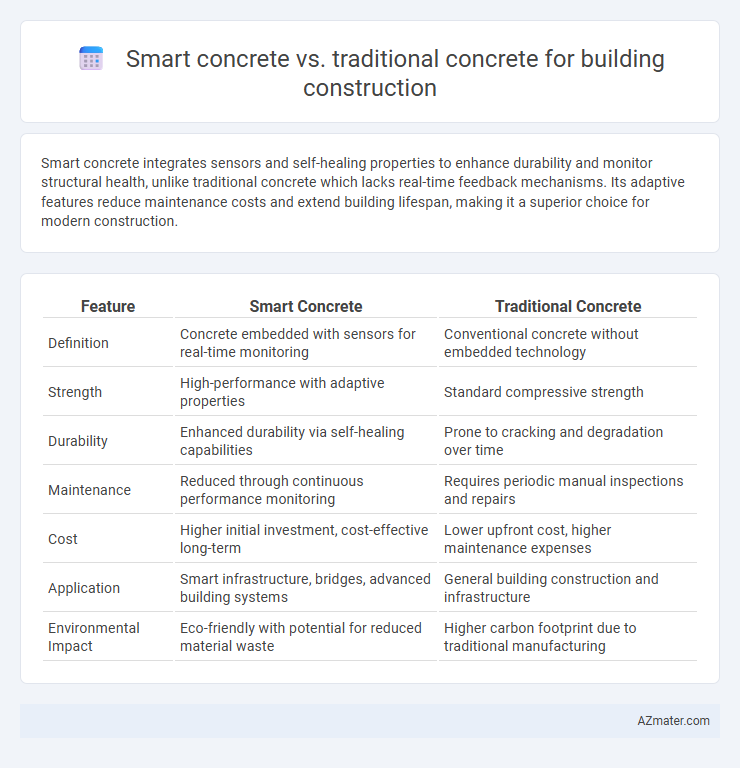Smart concrete integrates sensors and self-healing properties to enhance durability and monitor structural health, unlike traditional concrete which lacks real-time feedback mechanisms. Its adaptive features reduce maintenance costs and extend building lifespan, making it a superior choice for modern construction.
Table of Comparison
| Feature | Smart Concrete | Traditional Concrete |
|---|---|---|
| Definition | Concrete embedded with sensors for real-time monitoring | Conventional concrete without embedded technology |
| Strength | High-performance with adaptive properties | Standard compressive strength |
| Durability | Enhanced durability via self-healing capabilities | Prone to cracking and degradation over time |
| Maintenance | Reduced through continuous performance monitoring | Requires periodic manual inspections and repairs |
| Cost | Higher initial investment, cost-effective long-term | Lower upfront cost, higher maintenance expenses |
| Application | Smart infrastructure, bridges, advanced building systems | General building construction and infrastructure |
| Environmental Impact | Eco-friendly with potential for reduced material waste | Higher carbon footprint due to traditional manufacturing |
Introduction to Concrete in Construction
Smart concrete incorporates advanced materials such as sensors, conductive additives, and self-healing agents to enhance durability, monitor structural health, and reduce maintenance costs in building construction. Traditional concrete, composed primarily of cement, aggregates, and water, remains the standard due to its strength and versatility but lacks real-time monitoring and adaptive properties. Integrating smart concrete technologies transforms construction by providing enhanced safety, longevity, and data-driven insights compared to conventional methods.
Defining Smart Concrete and Traditional Concrete
Smart concrete integrates sensors and self-healing materials to monitor structural health and repair minor cracks autonomously, enhancing durability and lifespan. Traditional concrete, composed primarily of cement, aggregates, and water, provides a strong and cost-effective foundation but lacks real-time monitoring and adaptive properties. The innovation in smart concrete offers significant advancements over conventional methods by improving safety and reducing maintenance costs in building construction.
Material Composition and Technology
Smart concrete incorporates advanced materials such as carbon nanotubes, graphene, and nano-sensors, enhancing properties like strength, durability, and self-monitoring capabilities compared to traditional concrete composed mainly of cement, sand, gravel, and water. The integration of IoT-enabled sensors within smart concrete allows real-time structural health monitoring and stress detection, improving maintenance efficiency and safety in building construction. Traditional concrete relies on passive structural support, whereas smart concrete leverages nanotechnology and embedded electronics to optimize performance and longevity.
Mechanical Properties Comparison
Smart concrete exhibits enhanced mechanical properties compared to traditional concrete, including higher tensile strength, improved crack resistance, and greater durability under stress. Embedded sensors in smart concrete enable real-time monitoring of structural integrity, facilitating timely maintenance and reducing the risk of catastrophic failure. Traditional concrete, while cost-effective and widely used, typically lacks self-sensing capabilities and may show reduced performance under dynamic loading conditions.
Durability and Lifespan Analysis
Smart concrete enhances durability by incorporating self-healing properties and sensors that detect micro-cracks early, extending the lifespan of structures significantly beyond traditional concrete. Traditional concrete, while cost-effective and widely used, is more prone to cracking and degradation under environmental stress, resulting in frequent repairs and shorter service life. Studies show smart concrete can increase structural lifespan by up to 30%, reducing maintenance costs and improving overall resilience in building construction.
Sustainability and Environmental Impact
Smart concrete incorporates materials like nanomaterials and self-healing agents that enhance durability and reduce cracking, significantly lowering maintenance costs and extending building lifespan compared to traditional concrete. Its ability to absorb and convert environmental data into actionable feedback supports sustainable construction by optimizing resource use and reducing carbon emissions. Traditional concrete production accounts for approximately 8% of global CO2 emissions, whereas smart concrete innovations focus on reducing this impact through advanced mix designs and recycled components.
Cost Implications and Economic Benefits
Smart concrete integrates sensors and self-healing properties, reducing maintenance costs and extending the lifespan of structures, resulting in significant long-term economic benefits compared to traditional concrete. Although initial investment in smart concrete is higher due to advanced material technology and installation, the reduction in repair frequency and enhanced durability lowers overall lifecycle expenses. Cost implications favor smart concrete in large-scale projects where durability and monitoring decrease downtime and future repair expenses, optimizing the return on investment.
Installation and Maintenance Differences
Smart concrete incorporates sensors and self-healing capabilities, significantly reducing installation time by minimizing the need for manual repairs and extensive quality checks. Traditional concrete requires longer curing periods and frequent inspections to detect cracks or degradation, leading to increased maintenance efforts and costs. Maintenance for smart concrete is more efficient due to real-time monitoring, enabling early problem detection and automated healing processes, unlike traditional concrete's reactive maintenance approach.
Applications in Modern Building Projects
Smart concrete integrates sensors and self-healing materials, enhancing durability and real-time structural health monitoring in modern building projects. Traditional concrete, valued for its cost-effectiveness and simplicity, remains widely used in foundational and load-bearing applications but lacks advanced performance features. Innovative smart concrete applications include infrastructure resilience, energy-efficient buildings, and adaptive architectural designs, optimizing safety and sustainability in contemporary construction.
Future Trends in Concrete Technology
Smart concrete integrates sensors and self-healing properties to enhance structural durability and real-time monitoring, offering significant advancements over traditional concrete used in building construction. Future trends in concrete technology emphasize the development of eco-friendly materials, 3D printable concrete, and the integration of nanotechnology to improve strength, reduce carbon footprint, and optimize resource efficiency. Adoption of smart concrete in infrastructure promises extended lifespan, minimized maintenance costs, and improved safety through predictive analytics and automated damage detection systems.

Infographic: Smart concrete vs Traditional concrete for Building construction
 azmater.com
azmater.com